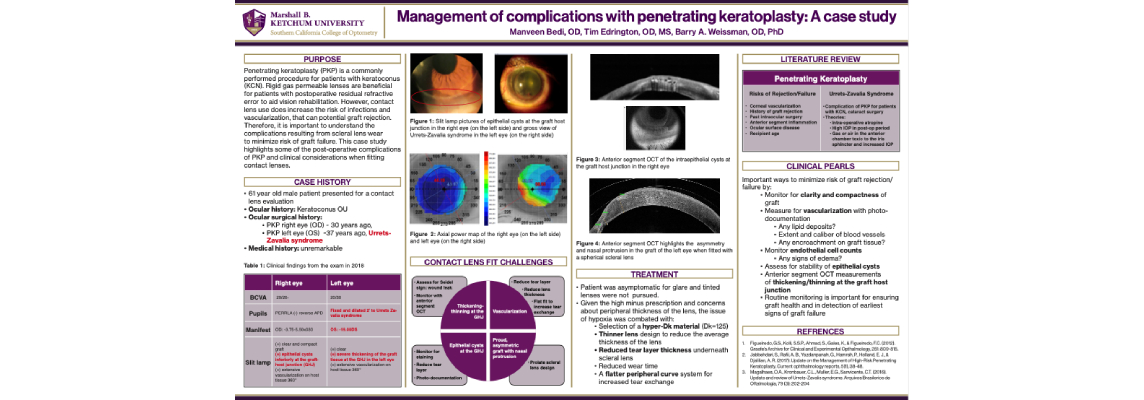This lecture details the selection and fitting process for specialty contact lens fitting in two patients cases. One case describes the fitting process of a scleral lens for a patient with keratoconus. The second pediatric case describes the use of bitoric corneal GP in amblyopia management for post-globe rupture repair with corneal irregularity.


This case series highlights the role of specialty contact lens fitting in two patients diagnosed with congenital Peters anomaly. Peters anomaly is a congenital malformation of the anterior chamber structures of the eye. Children will present with corneal opacity, iris malformation, and lenticular opacities that results in abnormal visual input and development. In severe cases, surgical intervention may improve visual potential and prevent amblyopia. In such cases, specialty contact lenses prove beneficial in maximizing visual rehabilitation and improving visual prognosis.

This lecture covers specialty lens fittings for a variety of corneal pathologies ranging from 19D of residual astgmatism secondary to astgmatism keratotomy, long term contact lens management of patients with boston keratoprosthesis, pediatrc congenital pathologies, and ocular surface conditons.

A lecture for 3rd year optometry students at the Marshall B. Ketchum Unversty. The primary objective was to describe the role of specialty contact lenses in pedatric population and describe the fitting procedure.

Lecture at the annual residency forum at the Marshall B. Ketchum University to 3rd and 4th year students. The lecture covers pathophysiology of Peters anomaly, long-term medical management, and visual rehabilitation with corneal GPs and prosthetic lenses.

Invited for a lecture at the 7th annual Resident's Day Program at the Arizona College of Optometry. This lecture covered common considerations and challenges when fitting specialty lenses for complicated post-surgical corneas.

Invited for a COPE-approved lecture at the Orange County Optometry Society to discuss the medical management os post-surgical corneas, graft rejection and failure, and considerations while fitting specialty contact lenses.

A lecture for second year optometry students at the Marshall B. Ketchum University. This lecture was a foundational course describing scleral lens anatomy, fitting process, and long term management of patients.

Penetrating keratoplasty (PKP) is a commonly performed procedure for patients with keratoconus (KCN). Rigid gas permeable lenses are beneficial for patients with postoperative residual refractive error to aid vision rehabilitation. However, contact lens use does increase the risk of infections, and neovascularization that can potentiate graft rejection. Therefore, it is important to understand the complications resulting from scleral lens wear to minimize risk of graft failure. This case study highlights some of the post-operative complications of PKP and clinical considerations when fitting contact lenses.

This case study highlights the diagnostic dilemma between keratoglobus (KG) and advanced pellucid marginal degeneration ("global pellucid marginal degeneration"). Due to limited literature, the pathophysiological processes of global PMD are not well understood, which makes the diagnosis of global PMD difficult especially when the entire cornea is involved.

Main Findings: Patients with advanced glaucoma report significant decline in functioning, their ability to interact in community, take care of self,and do leisure activities. Glaucoma imposes greater social burden on the elderly by impacting their sense of personal safety. Targeted visual and social rehabilitative programs are necessary to improve their wellbeing and independent functioning

Main Findings: There is a growing need for culturally sensitive care for South Asian women. By understanding the core cultural values and integrating them into clinical practice, Western healthcare providers may improve the quality of care they deliver and help women to extract the maximum benefit. Developing culturally competent support services may enhance effectiveness in addressing the healthcare needs of South Asian women and may serve other ethnic minorities in North America.

The initial diagnosis of keratoconus (KC) can be difficult, especially in situations in which patients are asymptomatic. This article discusses different diagnostic tests and slit-lamp findings that can help confirm the diagnosis. Once the diagnosis has been establishes, corneal or scleral GP contact lenses can be helpful for providing optimal and consistent vision for patients who have irregular corneas. An in-depth conversation about visual demands, vocation, and avocations can help narrow down a specific lens modality that would provide visual rehabilitation to patients and improve their quality of life.

Patients who have corneal irregularities, including corneal ectasias and transplants, often experience poor vision in standard spectacle or contact lens correction and require GP contact lenses. GPs are able to neutralize the corneal irregularity and provide optimal vision. When fitting both corneal and scleral GP lenses with spherical optics, it is not uncommon to find residual uncorrected astigmatism when performing a sphero-cylindrical over-refraction (SCOR). Practitioners are then tasked with determining whether the residual cylinder should be corrected and how it should be incorporated. This article will discuss methods to correct residual astigmatism and the possible difficulties that may be encountered.

Silicone hydrogels (SiHys) have become the gold standard for soft contact lens materials. SiHy materials are well known to provide greater oxygen permeability (Dk) in comparison to hydrogel lenses. This increased Dk results in reduced hypoxia-related complications such as vascularization and limbal hyperemia (Maldonado-Codina et al, 2004). When prescribing soft toric lenses, lens profile thickness strongly influences oxygen transmissibility (Dk/L) and is affected by the toric lens stabilization design, the power, and the material of the lens.
